Why Every Cell in Your Body is Like a Tiny Power Plant
Imagine you’re sprinting to catch the school bus. Your heart pounds, your muscles burn, and you’re breathing heavily. What’s happening inside your body at the cellular level is nothing short of amazing – millions of tiny power plants (your cells) are working overtime to produce the energy you need. This process is called cellular Respiration, and it’s one of the most fundamental processes keeping you alive right now.
Whether you’re studying for your IGCSE Biology exam or simply curious about how your body works, understanding respiration will give you insights into everything from why you breathe to how athletes train for peak performance. Let’s dive into this fascinating world where glucose meets oxygen to create the energy currency of life!
What is Cellular Respiration? The Basics Made Simple
Cellular Respiration is the process by which cells break down glucose (and other organic molecules) to release energy in the form of ATP (Adenosine Triphosphate). Think of ATP as the universal energy currency – just like you need money to buy things, your cells need ATP to power all their activities.
Key Definition Box:
Respiration: The chemical process in living organisms involving the breakdown of glucose to release energy, which is used to synthesize ATP from ADP + Pi.
The beauty of respiration lies in its efficiency. While a wood fire releases energy as heat and light (much of it wasted), cellular respiration captures energy in a controlled, step-by-step manner, storing it in chemical bonds for later use.
The Two Main Types of Respiration: When Oxygen Makes All the Difference
Aerobic Respiration: The Complete Breakdown
Aerobic respiration occurs when oxygen is present – it’s like having premium fuel for your cellular engines. This process completely breaks down glucose, releasing maximum energy.
The Overall Equation:
C₆H₁₂O₆ + 6O₂ → 6CO₂ + 6H₂O + Energy (38 ATP molecules)
Glucose + Oxygen → Carbon dioxide + Water + Energy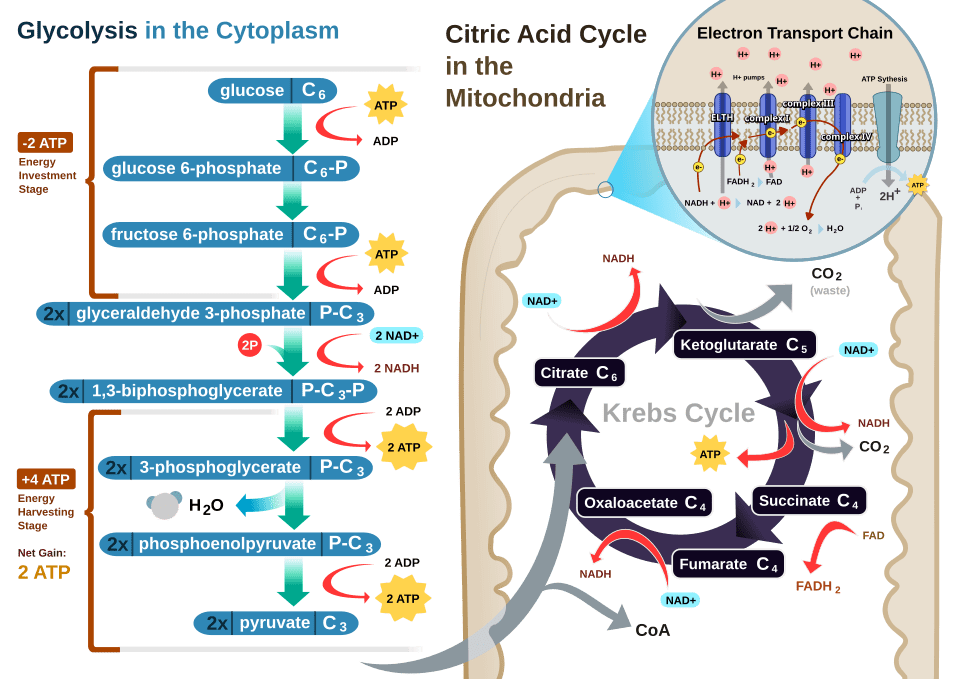
Anaerobic Respiration: The Emergency Backup System
When oxygen runs low (like during intense exercise), cells switch to anaerobic respiration. It’s less efficient but crucial for survival in low-oxygen conditions.
In Animals (Lactic Acid Fermentation):
C₆H₁₂O₆ → 2C₃H₆O₃ + Energy (2 ATP molecules)
Glucose → Lactic acid + EnergyIn Plants and Yeast (Alcoholic Fermentation):
C₆H₁₂O₆ → 2C₂H₅OH + 2CO₂ + Energy (2 ATP molecules)
Glucose → Ethanol + Carbon dioxide + Energy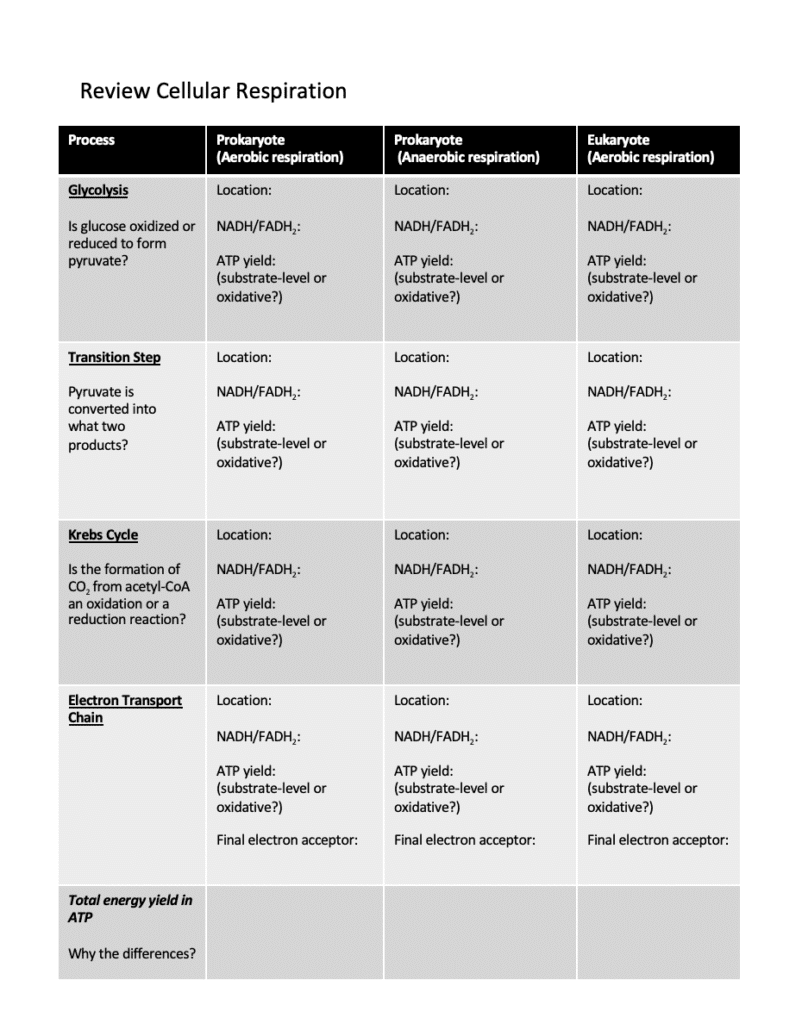
The Three Stages of Aerobic Respiration: A Step-by-Step Journey
Stage 1: Glycolysis – Breaking Down Glucose
Glycolysis occurs in the cytoplasm and doesn’t require oxygen. Think of it as the preprocessing stage where glucose gets broken down into smaller, more manageable pieces.
What Happens:
- One glucose molecule (6 carbons) splits into two pyruvate molecules (3 carbons each)
- Net gain: 2 ATP molecules
- Also produces: 2 NADH molecules (electron carriers)
Memory Tip: “Glyco-lysis” literally means “glucose-splitting” – remember it as the stage that splits the sugar!
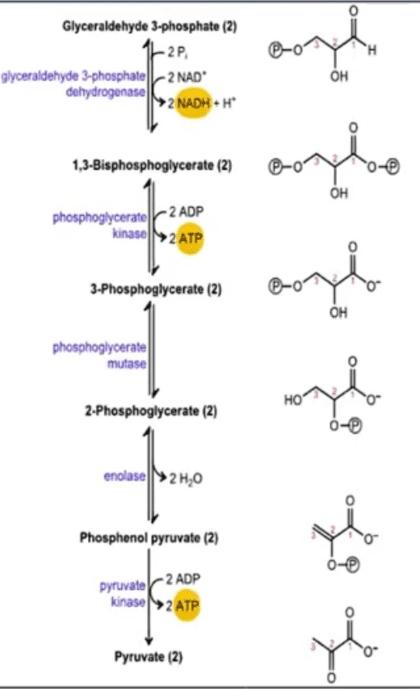
Stage 2: Krebs Cycle (Citric Acid Cycle) – The Central Hub
The Krebs cycle takes place in the mitochondrial matrix. If glycolysis is preprocessing, the Krebs cycle is where the real action happens – like a busy roundabout where pyruvate gets completely dismantled.
What Happens:
- Each pyruvate (from glycolysis) enters the cycle
- Complete oxidation occurs, releasing CO₂
- Produces: 2 ATP, 6 NADH, 2 FADH₂ per glucose molecule
Memory Tip: Think “Krebs = CO₂ release” – this is where you breathe out the carbon dioxide!
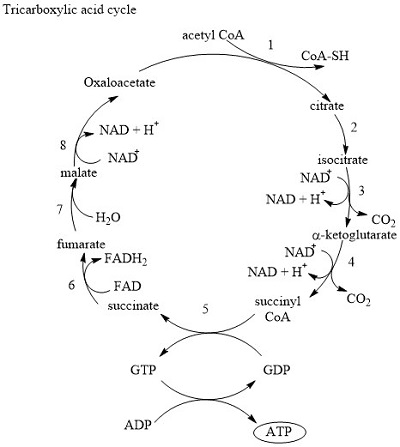
Stage 3: Electron Transport Chain – The Power Generator
This final stage occurs on the inner mitochondrial membrane and produces the majority of ATP. Think of it as a series of conveyor belts passing electrons down, with each transfer releasing energy.
What Happens:
- NADH and FADH₂ from previous stages donate electrons
- Electrons pass through protein complexes, releasing energy
- This energy pumps protons, creating a gradient
- ATP synthase uses this gradient to produce ATP
- Oxygen acts as the final electron acceptor, forming water
ATP Yield: Approximately 32-34 ATP molecules from this stage alone!
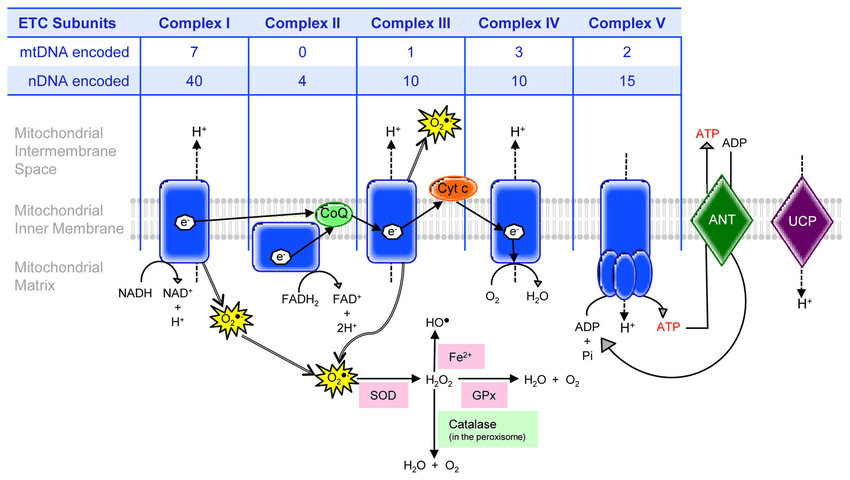
Real-Life Applications: Where You See Respiration in Action
Exercise and Athletic Performance
Ever wondered why athletes train differently for sprinting versus marathon running? It’s all about respiration!
- Sprint events: Rely heavily on anaerobic respiration (quick energy, but limited duration)
- Endurance events: Depend on aerobic respiration (sustained energy production)
- Recovery period: When you’re “catching your breath,” you’re paying back the oxygen debt from anaerobic respiration
Bread Making and Brewing
Yeast uses anaerobic respiration in these processes:
- Bread: CO₂ produced makes dough rise; alcohol evaporates during baking
- Brewing: Alcohol is the desired product; CO₂ creates carbonation
Plant Respiration vs. Photosynthesis
Students often confuse these processes. Here’s the key difference:
- Photosynthesis: Makes glucose using light energy (only in light)
- Respiration: Breaks down glucose to release energy (happens 24/7)
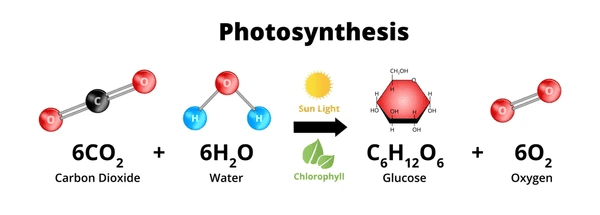
Factors Affecting Respiration Rate
Understanding what influences respiration helps explain many biological phenomena:
Temperature
- Higher temperatures: Increase enzyme activity, faster respiration (up to a point)
- Too high: Enzymes denature, respiration stops
- Lower temperatures: Slower respiration rate
Oxygen Availability
- High oxygen: Maximum aerobic respiration
- Low oxygen: Switch to less efficient anaerobic respiration
- No oxygen: Only anaerobic respiration possible
Glucose Concentration
- More glucose: Higher potential for respiration
- Limited glucose: Cells may use alternative substrates (fats, proteins)
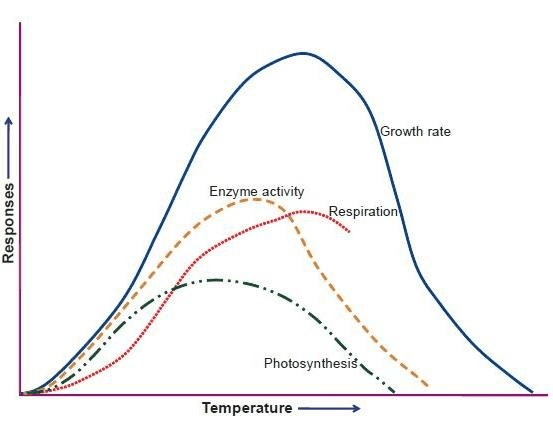
Key Formulas and Equations Box
Aerobic Respiration:
C₆H₁₂O₆ + 6O₂ → 6CO₂ + 6H₂O + 38 ATP
Anaerobic Respiration (Animals):
C₆H₁₂O₆ → 2C₃H₆O₃ + 2 ATP
Anaerobic Respiration (Plants/Yeast):
C₆H₁₂O₆ → 2C₂H₅OH + 2CO₂ + 2 ATP
ATP Synthesis:
ADP + Pi + Energy → ATP
Common Mistakes to Avoid
- Confusing respiration with breathing: Breathing is just gas exchange; respiration is the cellular process
- Thinking plants don’t respire: Plants both photosynthesize AND respire
- Forgetting about anaerobic respiration: It’s not just about oxygen-present conditions
- Mixing up reactants and products: Practice writing equations until they’re automatic
- Ignoring the importance of mitochondria: Most ATP production happens here
Test Yourself: Quick Check Questions
- Where in the cell does glycolysis occur?
- What is the net ATP gain from glycolysis?
- Why do muscle cells have many mitochondria?
- What happens to lactic acid produced during anaerobic respiration in muscles?
- Name the three stages of aerobic respiration in order.
Answers: 1) Cytoplasm, 2) 2 ATP, 3) High energy demand, 4) Converted back when oxygen available, 5) Glycolysis, Krebs cycle, Electron transport chain
Quick Revision Notes
Aerobic Respiration Summary:
- Location: Cytoplasm (glycolysis) + Mitochondria (Krebs cycle + ETC)
- Requirements: Glucose + Oxygen
- Products: CO₂ + H₂O + 38 ATP
- Efficiency: High (complete glucose breakdown)
Anaerobic Respiration Summary:
- Location: Cytoplasm only
- Requirements: Glucose (no oxygen)
- Products (Animals): Lactic acid + 2 ATP
- Products (Plants/Yeast): Ethanol + CO₂ + 2 ATP
- Efficiency: Low (incomplete glucose breakdown)
Key Differences Table:
| Aspect | Aerobic | Anaerobic |
|---|---|---|
| Oxygen needed | Yes | No |
| Location | Cytoplasm + Mitochondria | Cytoplasm only |
| ATP yield | 38 molecules | 2 molecules |
| End products | CO₂ + H₂O | Lactic acid OR Ethanol + CO₂ |
| Duration | Sustainable | Short-term |
Exam Tips and Strategies
What Examiners Love to Ask:
- Equation questions: Be able to write and balance respiration equations
- Comparison questions: Aerobic vs anaerobic respiration
- Application questions: Why do athletes breathe heavily after exercise?
- Location questions: Where do different stages occur in the cell?
- Factor questions: What affects respiration rate and why?
Memory Techniques:
- “Glycolysis Keeps Everyone Cool” (Glycolysis → Krebs → Electron transport chain)
- “ATP = Cellular Money” (helps remember its importance)
- “Oxygen = Full Efficiency” (aerobic produces more ATP)
Drawing Tips:
- Always label mitochondria in respiration diagrams
- Show the direction of processes with arrows
- Include ATP production at each stage
- Don’t forget to show where CO₂ and H₂O are produced
Looking Forward: Connections to Other Topics
Understanding respiration connects to many other IGCSE Biology topics:
- Topic 6 (Plant Nutrition): How photosynthesis and respiration complement each other
- Topic 9 (Transport in Animals): Why we need circulatory systems to deliver oxygen
- Topic 11 (Gas Exchange): How breathing supports cellular respiration
- Topic 13 (Excretion): How we remove CO₂ waste from respiration
Important Exam Questions Practice
Question 1: Explain why the yield of ATP is different in aerobic and anaerobic respiration. (6 marks)
Question 2: A student investigated the effect of temperature on respiration rate in yeast. Describe how they could carry out this investigation safely. (8 marks)
Question 3: Explain the importance of the electron transport chain in aerobic respiration. (4 marks)
Question 4: Compare and contrast respiration in plants and animals. (6 marks)
Your Next Steps to Mastery
Congratulations! You’ve just absorbed one of the most important topics in biology. Respiration isn’t just an exam topic – it’s the fundamental process that powers every moment of your life.
To solidify your understanding:
- Practice drawing: Sketch the respiration pathways from memory
- Make connections: Link respiration to exercise, cooking, and plant growth
- Teach others: Explain the process to friends or family
- Question everything: Why do we breathe faster when exercising? Why do plants need mitochondria if they photosynthesize?
Related topics to explore next:
- Gas Exchange Systems: How organisms get oxygen to their cells
- Transport Systems: How materials move around organisms
- Photosynthesis: The complementary process in plants
Remember, every time you take a breath, millions of your cells are using that oxygen in the incredible process you’ve just learned about. You’re not just studying biology – you’re understanding the very essence of what keeps you alive!
Keep going, future biologist! Your understanding of respiration puts you well on your way to mastering IGCSE Biology. The cellular world is full of amazing processes just waiting for you to discover them.
Recommended –


1 thought on “Respiration | IGCSE Biology Topic 12 Complete Guide”